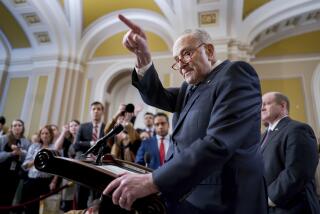Conferees Limit B-2s to 15; Craft Could Be Dead
- Share via
WASHINGTON — In a major setback for the B-2 bomber, House and Senate negotiators Thursday agreed to a compromise 1992 defense bill that provides no funding for the bomber beyond the 15 already in production.
The Pentagon bill, which would authorize $290 billion in defense spending for the year that began Oct. 1, sets aside $1 billion for the production of a 16th bomber but requires that the House and Senate vote to unfreeze the funds before they can be used to build the plane.
Although proponents of the $68-billion aircraft program are expected to hail the compromise as one that keeps the B-2 alive, opponents said Thursday that the bill spells the death of the Stealth bomber program, because the House is not expected to authorize the use of the additional funds.
In either event, the compromise is a defeat for the Defense Department, which had sought funds to build four more planes in fiscal 1992. Pentagon leaders have said that they want to build 75 of the planes, at a cost of $870 million apiece.
Meanwhile, the efforts by the negotiators--a conference committee consisting of members from the House and Senate Armed Services committees--to approve the compromise on the overall defense authorization bill ran into a snag late Thursday.
The problem was Senate Republicans’ concern about a Democrat-led proposal to provide $1 billion in humanitarian aid to the Soviet Union, senators said. Because the package was stalled, a press conference previously called for today to announce the defense budget compromise was canceled.
The compromise on the B-2 could deal a severe blow to the Northrop Corp., which is building the planes in Palmdale, Calif. However, Northrop executives remained optimistic about the future of the B-2 on Thursday, calling the compromise a cautious endorsement of the program rather than its death knell.
“The way we look at it is that Congress recognizes the value of and need for the B-2 and wants to proceed cautiously, and we’ll do that,” Northrop spokesman Les Daley said. “It shows they’re willing to fund 90% of what the Administration asked for and approach it cautiously. Ninety percent is something of an endorsement,” Daley added.
The House-Senate compromise earmarked $1.8 billion to complete production of the first 15 B-2 planes approved by Congress and $1.5 billion to complete development of Stealth technologies designed for the plane. Along with the $1 billion of “frozen” funds, the compromise measure does appear to provide all but $400 million of the Bush Administration’s request.
But, while spending to complete research and development and production of the first 15 bombers has not been controversial, lawmakers are deeply split over whether to fund any additional production.
The deal was made as lawmakers perceived softening support for the program in the Bush Administration. Last May, Bush threatened to veto any defense bill that does not provide funds for his principal strategic priorities, which included the B-2 and the Strategic Defense Initiative.
But, last week, in a bland statement of support for the B-2 program, Bush did not renew the veto threat, prompting many to conclude that the President is backing away from his insistence on the 75-plane force.
For some B-2 opponents, Thursday’s compromise clearly represented the end of the program.
“It’s only taken the collapse of the Soviet Union, the cost of the aircraft reaching almost a billion dollars a copy, budget deficits above $280 billion and three years of hard work to get to this point,” said Rep. John R. Kasich (R-Ohio).
However, Pentagon officials cautioned that there may be more bargaining before any vote is taken on authorizing additional production. The fact that the additional funding for the B-2 could be approved as a rider to an unrelated piece of legislation suggests that the Bush Administration might still be able to rally support for the program by offering lawmakers cooperation in other areas.
“I would not read this as in any way killing the B-2,” said a top Pentagon official. “Both sides will declare victory.”
In other developments on the 1992 defense bill, the negotiators agreed to provide $4 billion for work on a limited missile defense system, including $390 million to develop space-based interceptors called “Brilliant Pebbles.” Although that is more than $1 billion less than the Pentagon sought for the Strategic Defense Initiative, it is considered by Pentagon leaders to be a strong endorsement of the direction they hope to take.
Sen. Sam Nunn (D-Ga.), chairman of the Senate Armed Services Committee, who has been a critical supporter of both the SDI and B-2 programs, had no comment on Thursday’s action.
The Air Force recently notified Congress that in flight tests the B-2’s ability to elude air defense radar has fallen short of expectations. Pentagon spokesman Pete Williams said Thursday that, although the Air Force is continuing to investigate ways to improve the B-2’s performance, it is also examining the need for the high levels of “stealthiness” that the Air Force first specified as a goal of the program.
More to Read
Sign up for Essential California
The most important California stories and recommendations in your inbox every morning.
You may occasionally receive promotional content from the Los Angeles Times.














